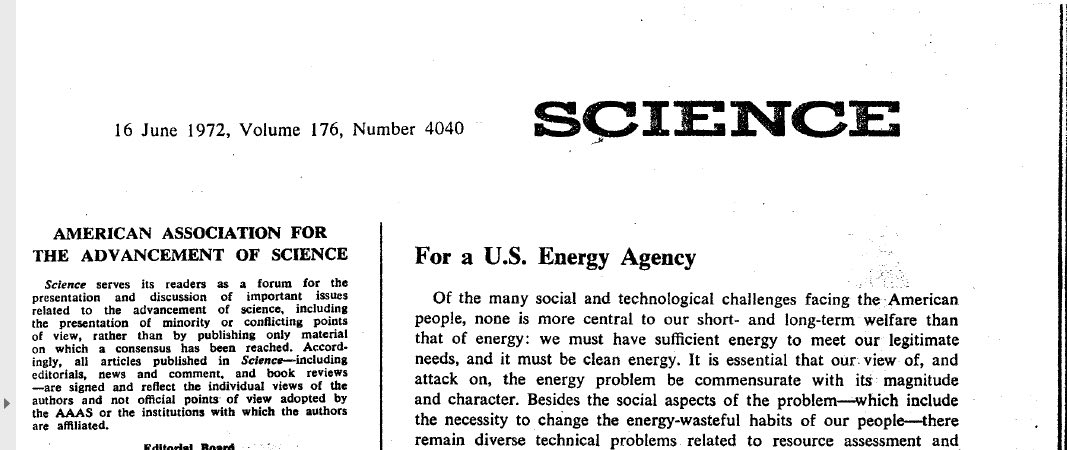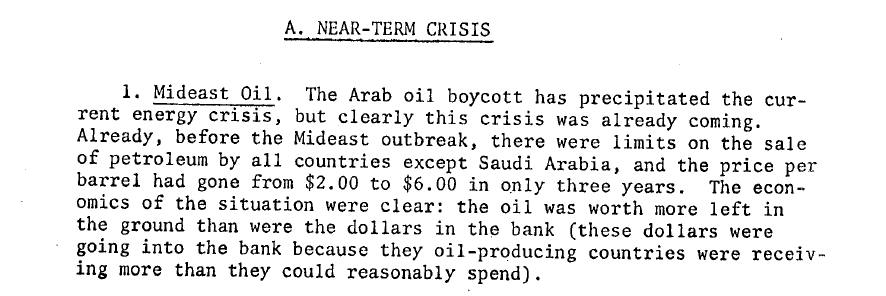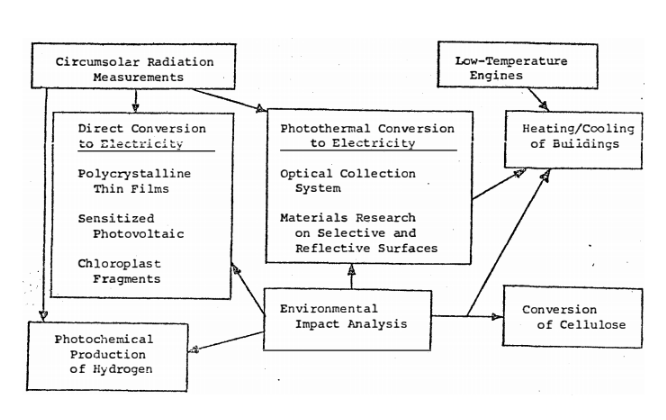1970s

The 1970s
The 1970s were a decade of great expansion. Nationally, a host of new environmental laws had just been passed to protect the nation's air, water, and land. At Berkeley Lab, an environmental focus takes shape as well when then-director Edwin McMillan establishes the Environmental Program and the first environmental funding arrives for what would someday become the Energy Technologies Area.
Women's contributions became more visible: Barbara West became administrator for the Energy and Environment division; Nancy Brown was hired to the combustion group; and Helen Michel co-led research that revealed the famed Plate of Brass was a hoax. The 1970s were further defined by the oil crisis of 1973, which inspired Art Rosenfeld and other researchers in the Lab's Physics Division to take a critical look at energy efficiency and develop it into a credible scientific discipline.
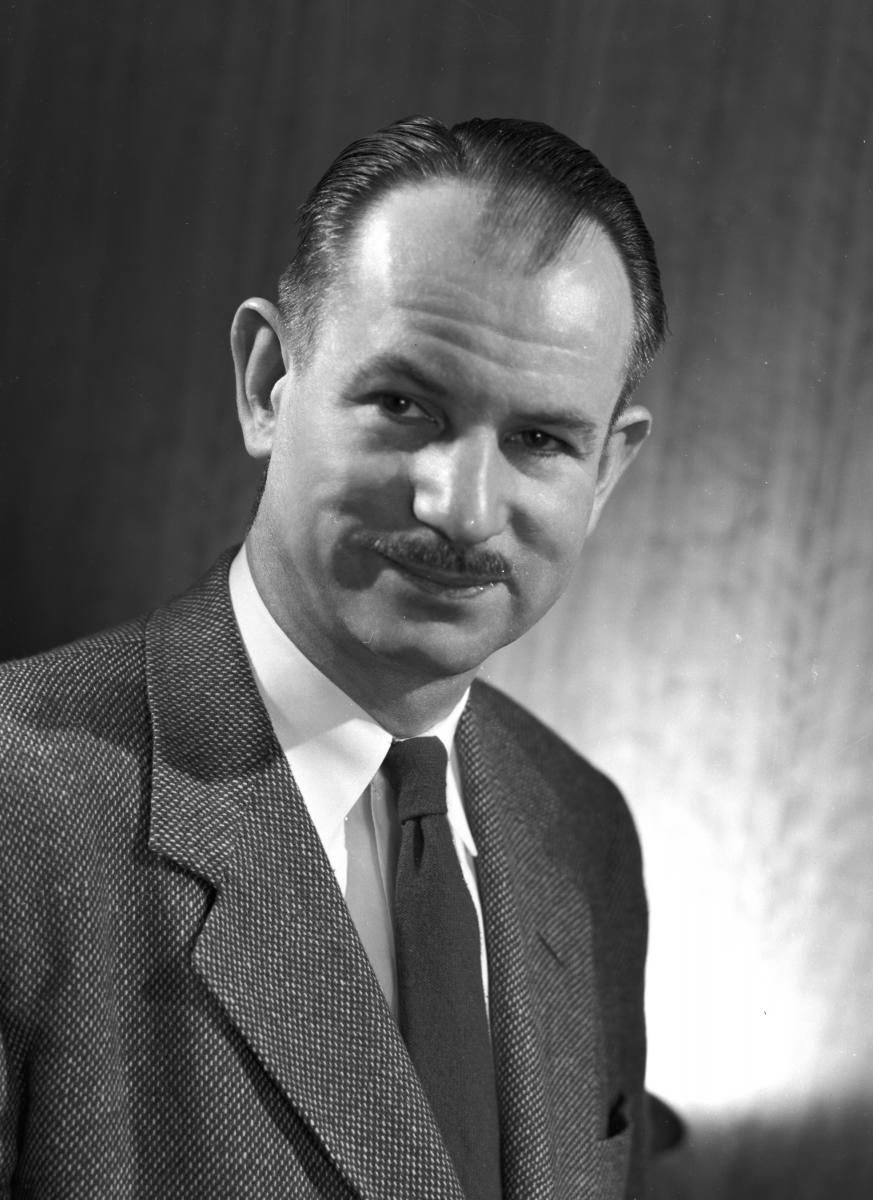 In 1970, Director Edwin McMillan founds the Environmental Program, with continued exploration of how Berkeley Lab can best assist with the "environmental problem."
In 1970, Director Edwin McMillan founds the Environmental Program, with continued exploration of how Berkeley Lab can best assist with the "environmental problem."
February 4 - Second meeting on the environmental problem
Informal meeting on the possible role of Berkeley Lab in studying the environmental problem. The meeting included about 40 attendees, including Edwin McMillan, Andy Sessler, Jack Hollander, Will Siri and Art Rosenfeld.
https://drive.google.com/file/d/1LRJQSQy4pX6AvFGyz7PirNDIlr_oytQO/view?usp=sharing
February 5 - Ideas for environmental projects are proposed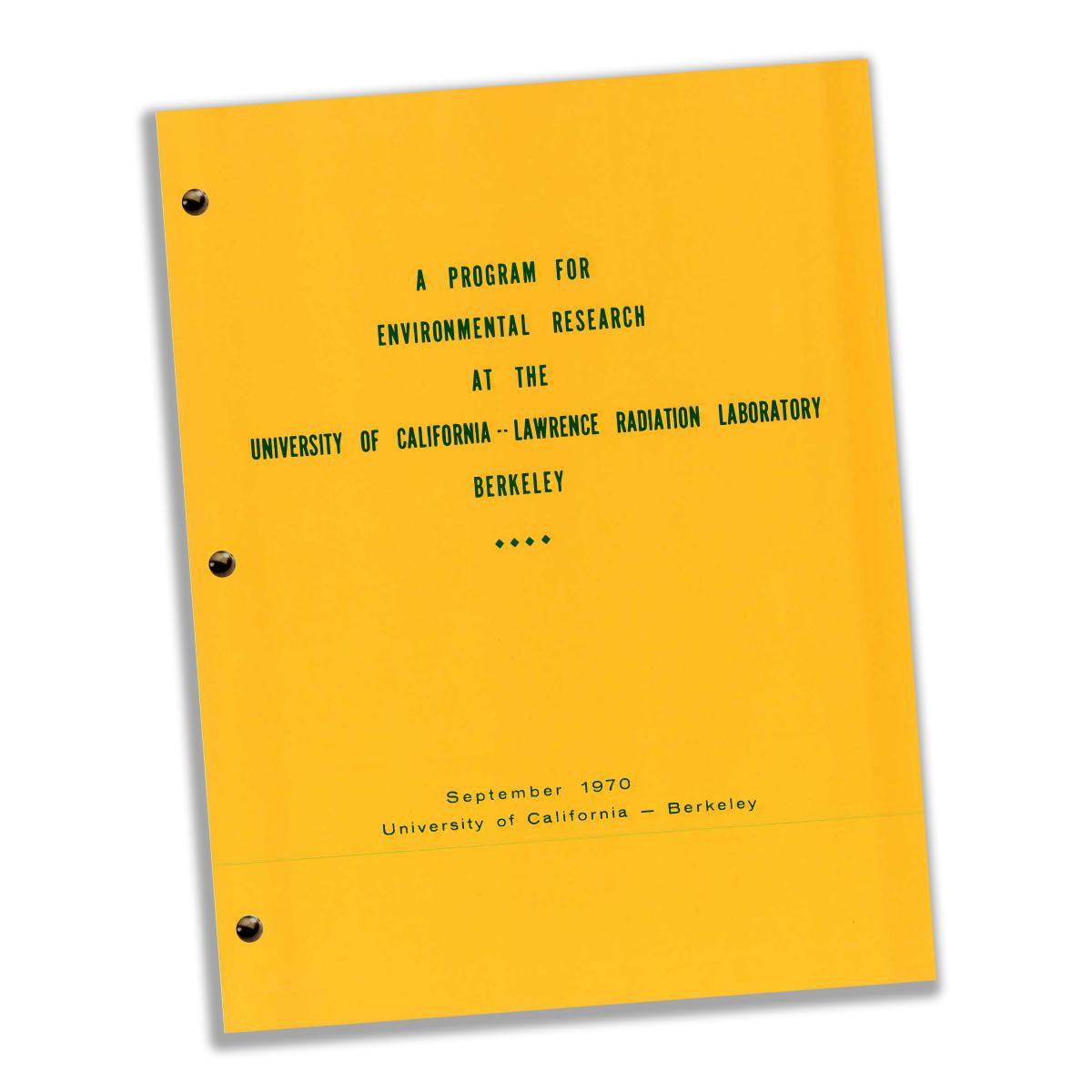
Ideas for environmental projects start flowing in to Sessler.
September - "Yellow book" lays out a program for the Lab and on campus
December 18 - Environmental Research Program launched
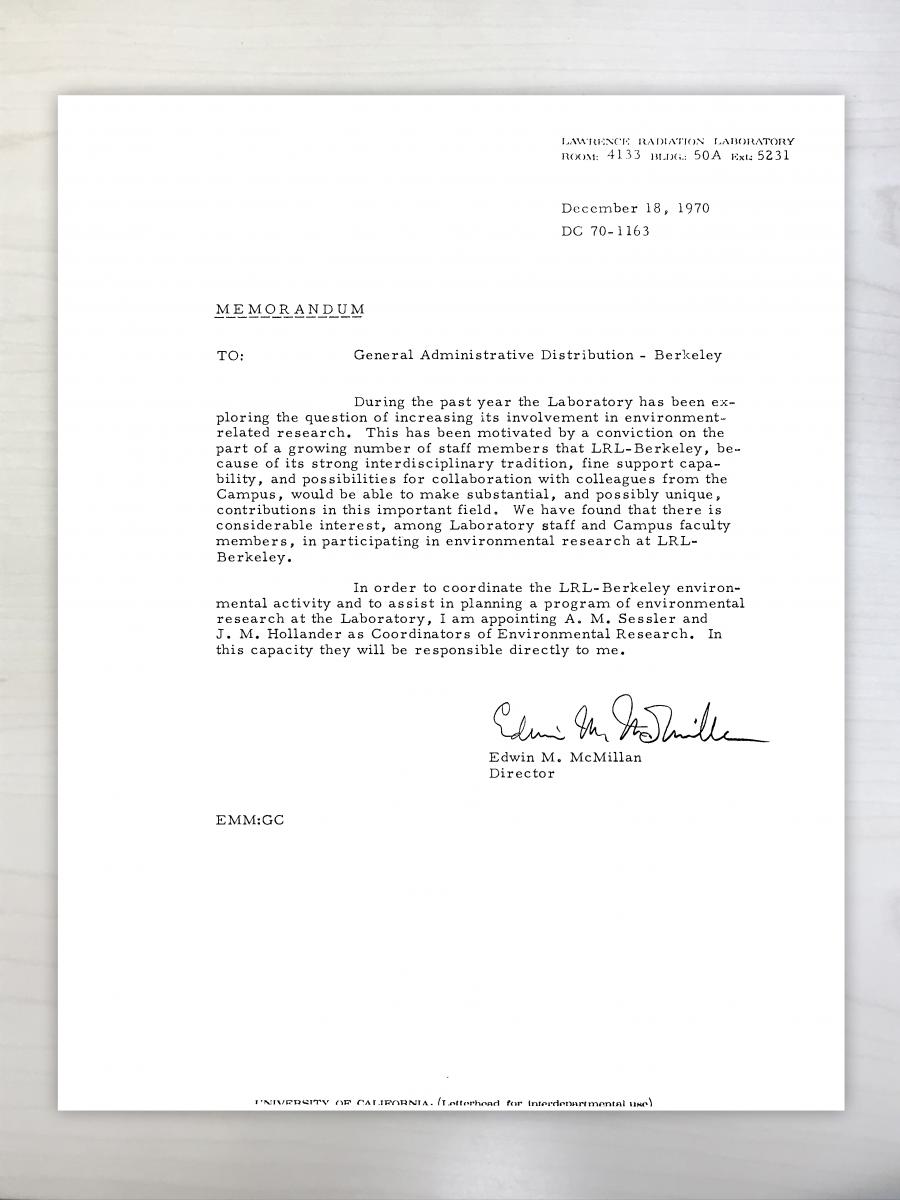 Environmental Research Program is started by Director McMillan, led by Sessler and Hollander.
Environmental Research Program is started by Director McMillan, led by Sessler and Hollander.
End of year - Lab is eligible for National Science Foundation funding.
The National Science Foundation launches the RANN (Research Applied to National Needs) program, for which U.S. DOE labs are eligible.
The building energy-efficiency team realizes a huge amount of energy is being lost through inefficient windows. With U.S. Department of Energy (DOE) funding, researchers partner with industry to develop today’s energy-efficient windows, ultimately saving billions of dollars in energy costs worldwide
In 1971, the Lab is renamed Lawrence Berkeley Laboratory.
June - First outside funding arrives
The Environmental Research Program's project, a survey of instrumentation for environmental monitoring, is funded by the National Science Foundation—RANN program. Principals include Bob Budnitz (pictured at left), Craig Hollowell (pictured at right), Dick Mack, and Nabil Amer.
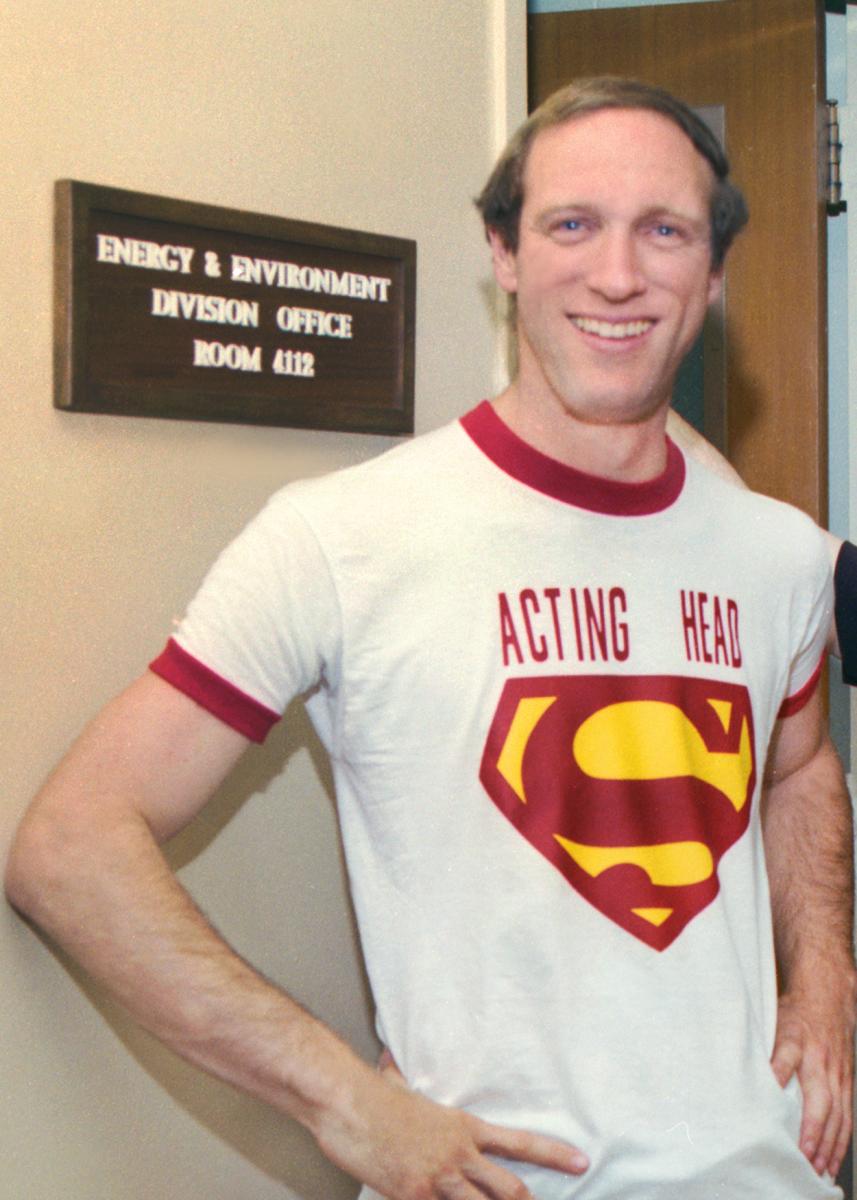
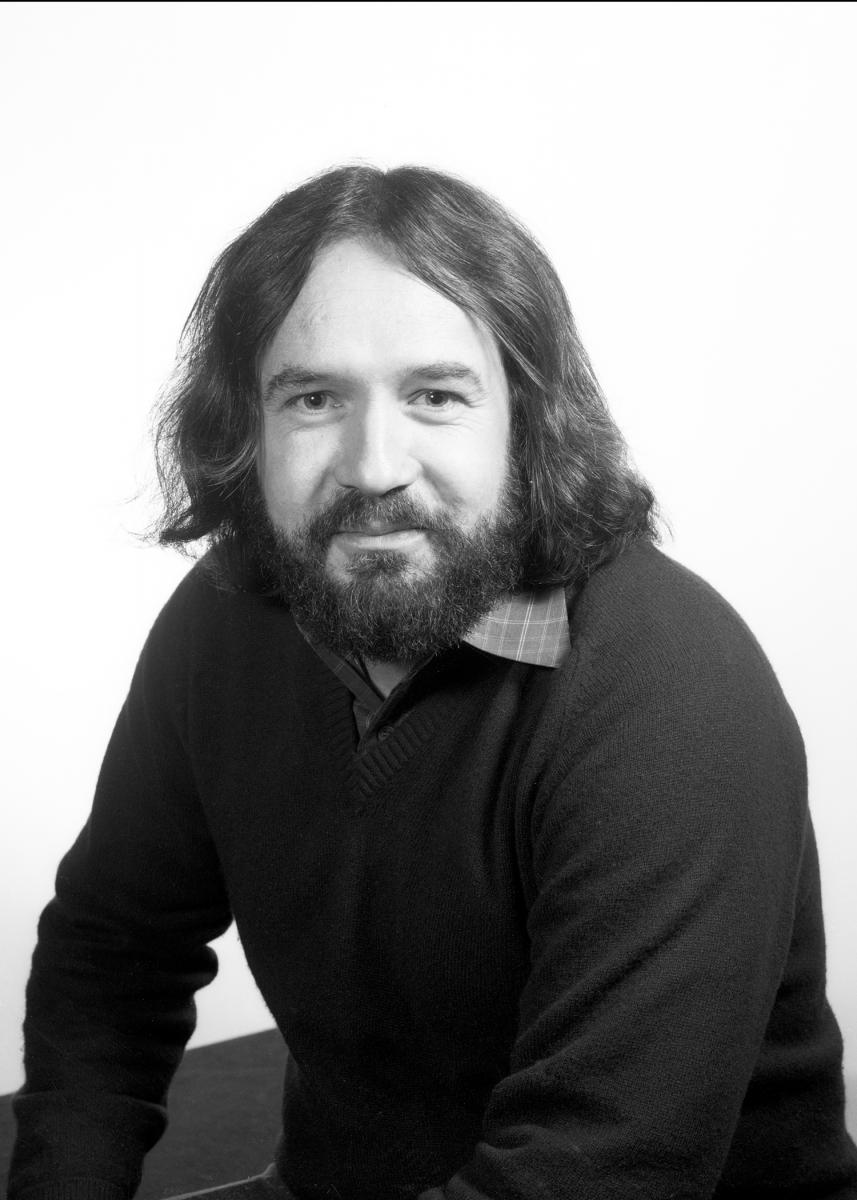
Throughout 1971 - University of California separates Berkeley and Livermore
University of California renames the Lawrence Radiation Laboratory sites as Lawrence Berkeley Laboratory (Berkeley Lab) and Lawrence Livermore Laboratory and begins the process of administratively separating the (now) two labs.
October 28 - California faces the energy crisis
Speech by California Lt. Governor Edwin Reinecke includes the energy crisis as one of many problems science can address.
In 1972, the "energy" research area joins the environmental focus at Berkeley Lab.
April 14 - Atomic Energy Commission chairman gives memorable speech
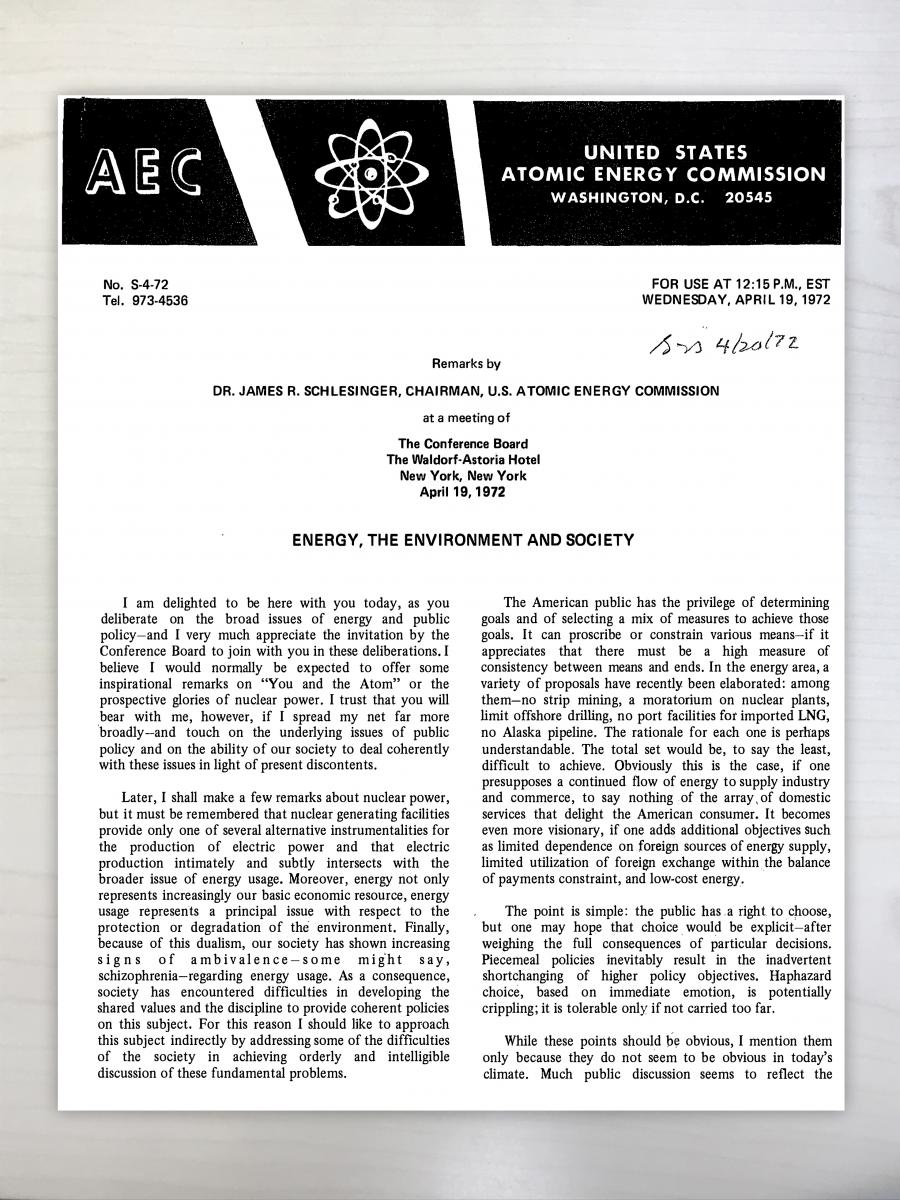 Chairman of the Atomic Energy Commission, James Schlesinger, gives a speech about the energy situation that has stood the test of time.
Chairman of the Atomic Energy Commission, James Schlesinger, gives a speech about the energy situation that has stood the test of time.
May 2 - Energy and Environment Program established
McMillan changes name of what will someday be the Energy Technologies Area to Energy and Environment Programs and appoints Hollander as assistant (Lab) director for the programs.
June 16 - Seaborg argues for U.S. Energy Agency
Glenn Seaborg publishes an editorial in Science magazine with the title "For a U.S. Energy Agency." He describes the then-situation with respect to energy—not that different from today—and proposes that the Atomic Energy Commission be transformed into the U.S. Energy Agency.
July 28 - Letter to Energy and Survival Program
Letter from Senator John Tunney (D, CA) to "Dr. Jack Hollander, Assistant Director Energy and Survival Program, Radiation Lab, UCB." Tunney sees a coming mismatch between supply and demand, and he calls for a national energy policy.
August 15 - "Modifying demand" is mentioned
"Elements of a National Energy Policy" by Hollander and John Harte includes a section on modifying the demand for energy.

November 7 - Richard Nixon elected to second presidential term
That year - Origins of the Solar Energy Program
During 1972, Mike Wahlig, formerly in the University of California's Physics Division, works towards developing a Solar Energy Program and recruits the Physics Division's Don Grether to help.
Atmospheric Aerosol Research Group Created
Tihomir (Tica) Novakov creates the Atmospheric Aerosol Research Group and inspires the now-mainstream field of research on carbonaceous aerosols. The group conducts groundbreaking research on heterogeneous atmospheric reactions, the importance of carbonaceous aerosols as cloud condensation nuclei, and the optical properties and climate implications of sunlight absorbing black and organic carbon.
Researchers lay out a theoretical foundation for engineering design of electrochemical systems, including electrical energy storage, clarifying the physicochemical laws that govern the behavior of electrochemical systems and demonstrate how to use these laws to correctly formulate and solve problems associated with batteries, fuel cells, electrolyzers, and related technologies.
In 1973, Andy Sessler became Berkeley Lab’s third director just two weeks after the start of the 1973 oil embargo, when gas prices soared and lines at gas stations snaked for several blocks. The energy crisis had begun. On his first day in office, November 1, 1973, and with the support of the rapidly expanding growth of federal support for energy technology research and development, he established the Energy and Environment Division.
March - Manhattan Project proposed for energy
Key senators propose a massive "Manhattan Project" for energy research and development. It never happened.
September - Sessler to become Berkeley Lab director
Director McMillan announces that Andy Sessler will become the Lab director November 1.
September 24 - Sessler outlines challenges
Sessler sends a memo to "The Staff of the Lab" reviewing the Lab's past successes and pointing to challenges that lie ahead.
October 6 - First energy crisis
Egypt and Syria attack Israel during Yom Kippur, which leads to the oil embargo and the first energy crisis.
November 1 - Energy and Environment Division established
Newly appointed Lab Director Andy Sessler establishes the Energy and Environment Division and appoints Jack Hollander as division head.
November 7 - Project Independence announced
President Nixon announces Project Independence, recalling the Manhattan Project, with a goal to achieve energy self-sufficiency by 1980.
December 17 - Near-term crisis
The price of a barrel of oil has gone from $2/barrel to $6/barrel. Prepared by Sessler for Senator Alan Cranston.
Throughout 1973 - Fusion and geothermal programs move to Energy and Environment
Ongoing controlled fusion effort transferred to Energy and Environment Division.
Paul Witherspoon starts geothermal program in the Energy and Environment Division, which later led to the Earth Sciences Division.
In 1974, the Atomic Energy Commission comes to an end, as such. American Physical Society summer study introduces the concept of energy "efficiency."
February - Solar Program projects
Pictured above: Projects in the Solar Program. More than 40 years later, the world is still working on many of the same technologies.
February 1 - Berkeley Lab's organizational chart
Click the image below to download the full chart.
March - Energy and Environment Division helps BART
Energy and Environment Division under contract with Bay Area Rapid Transit (BART) to help with braking systems, motor performance, automatic control equipment, and general troubleshooting.
Spring 1974 - First solar funding
The first solar funding: The Circumsolar Telescope Project. Funding is from the National Science Foundation—RANN program. Don Grether transfers from Physics to the Energy and Environment Division.
Summer 1974 - Summer study on efficient use of energy
The American Physical Society holds summer study at Princeton on "Efficient Use of Energy: A Physics Perspective." Art Rosenfeld and Sam Berman (Stanford Linear Accelerator Center) help organize.
October - Atomic Energy Commission abolished
Atomic Energy Commission is abolished, giving way to the Nuclear Regulatory Commission and Energy Research and Development Administration.
End of Year - First Energy and Environment Annual Report
The first Annual Report was organized by Environmental Science; Solar Energy Research and Development; Instrumentation and Measurement; New Technology and Spin-off Research; Fossil Energy Research and Development; Geothermal Energy and the Geosciences; and Plasma Physics and Controlled Fusion Research. Carl Blumstein is the editor.
In 1975, energy analysis and buildings become a focus for Berkeley Lab.
Early in 1975 - Will Siri starts Energy Analysis Program
Will Siri joins Energy and Environment as the Leader of the Energy Analysis Program.
That year - Rosenfeld and Berman move to Energy and Environment
Rosenfeld moves from the Physics Division to Energy and Environment. Berman leaves Stanford for Berkeley Lab/Energy and Environment. Together they form the Energy Efficient Buildings Program.
Berkeley Summer Study attracts experts from around the country to engage with UC Berkeley and Berkeley Lab staff to formulate/prioritize needs/opportunities related to energy. Upon conclusion, Berkeley Lab was asked to to submit a proposal for follow-on work, which led to new funding in early 1976. A “Proceedings” (14 papers) of the Berkeley Summer Study was published in the inaugural issue of the new journal Energy and Buildings, Vol 1, Issue 1 in May 1977.
Fall - Hollander steps down as Energy and Environment Head
Hollander steps down to lead a major National Academy of Science study: Committee on Nuclear and Alternative Energy Systems. Bob Budnitz is appointed acting head, Mel Simmons acting deputy head. The Energy and Environment office is located on the 4th floor of Building 50A.
End of year - Annual Report includes indoor air quality
Annual report includes first article concerning indoor air quality: "Combustion-Generated Indoor Air Pollution" by Craig Hollowell, Bob Budnitz, George Case, and Greg Traynor.
In 1976, the United States celebrates its bicentennial, and the Carter era begins.
July 12 - Steve Selkowitz is hired for windows research and development
Steve Selkowitz, who had first engaged with Rosenfeld/Berman in the 1975 Summer Study and
helped write the followup proposal for additional funding, is hired to lead the advanced window development
effort, while Sam Berman focuses on advanced lighting. Rosenfeld develops Two-zone,
which becomes Cal-ERDA and then DOE-2 building energy simulation model.
That year - Barbara West is appointed Energy and Environment administrator
September - Nancy Brown is hired into combustion group
November - Jimmy Carter elected president
End of Year - Annual Report has articles on new areas
The Annual Report has first articles on buildings, combustion, and energy analysis. The division's staff numbers 180, not including graduate students.
The year 1977 was an era of even more growth in energy technology research and development. That year also heralded the advent of the U.S. Department of Energy and the downsizing of the Energy and Environment Division.
February (about) - Mel Simmons leaves
Mel Simmons takes a leave of absence to work on energy policy at the Solar Energy Research Institute (now the National Renewable Energy Laboratory) and never returns.
April - Energy declared moral equivalent of war
President Carter declares that the energy effort is the "moral equivalent of war" and launches a large program "to give us energy security," including the solar demonstration program and the Synfuels Corporation.
May - Energy modes: complacency and panic
With respect to energy, "We have only two modes: complacency and panic," James Schlesinger said in The New York Times.
August - U.S. Department of Energy established
President Carter establishes the U.S. Department of Energy, which takes over the responsibilities of Energy Research and Development Administration and other energy-related federal agencies.
Summer - Symposium on Carter's energy policy
Energy and Environment and University of California-Berkeley Energy and Resources Group hold a symposium on "First Impressions of Carter's Energy Policies."
August - Schlesinger becomes first U.S. secretary of energy
Fall - Plate of Brass is a hoax
Energy and Environment's Frank Asaro and Helen Michel use Neutron Activation Analysis to prove that the plate of brass supposedly left at Point Reyes by Sir Francis Drake is a hoax.
That year - Hollander returns, but to campus
Jack Hollander returns to Berkeley, but to U.C.-Berkeley (not Berkeley Lab), and founds the University-wide Energy Research Group, which later became the University of California Energy Institute.
That year - Energy and Environment is downsized
The Earth Sciences Division split off from Energy and Environment. Fusion goes to the Accelerator Division, which is renamed the Accelerator and Fusion Research Division. The BART project goes to Engineering.
December - Mark Levine joins Energy Analysis
Mark Levine is hired to join the Energy Analysis Program.
That Year - First external review of Energy and Environment
The first Lab Director's review of the Division. Paul Craig was the chair, and committee members included John Holdren, William Brobeck, C. Judson King, and Chang Tien.
End of Year - Programs in the Energy and Environment Division
The division has been downsized from nine to five programs: Chemical Process Research and Development, Energy Analysis, Energy Efficient Buildings, and Solar Energy. Staff decreases from 180 to 120.
In 1978, Energy and Environment welcomes Elton Cairns as head of the division.
First Windows Testing Facility
The Windows and Daylighting Group builds it first window testing facility in
Wurster Hall on campus, home of the UC Department of Architecture, to encourage more
interaction between the architectural professional and the growing building science group at
Berkeley Lab. Eventually, the thermal test facility was moved up the Hill to Berkeley Lab. An “artificial sky”
24’ diameter domed structure was built and operated until xx for daylighting research and
design studies. The building was eventually dismantled.
January - Jim McMahon hired into Energy Analysis
Spring - The Department of Energy funds Appropriate Technologies
The U.S. Department of Energy funds Energy and Environment (Charlie Case) to support Appropriate Energy Technologies in Arizona, Nevada, and Pacific Territories (islands). California and Hawaii were handled by other institutions. The largest grant was $49,000 for an "Agua-Power Barge." The smallest was $328.00 for a solar beeswax melter.
Summer - Budnitz leaves Berkeley Lab
Bob Budnitz leaves Berkeley Lab for the Nuclear Regulation Commission to work on nuclear safety. Sam Berman is appointed acting division head.
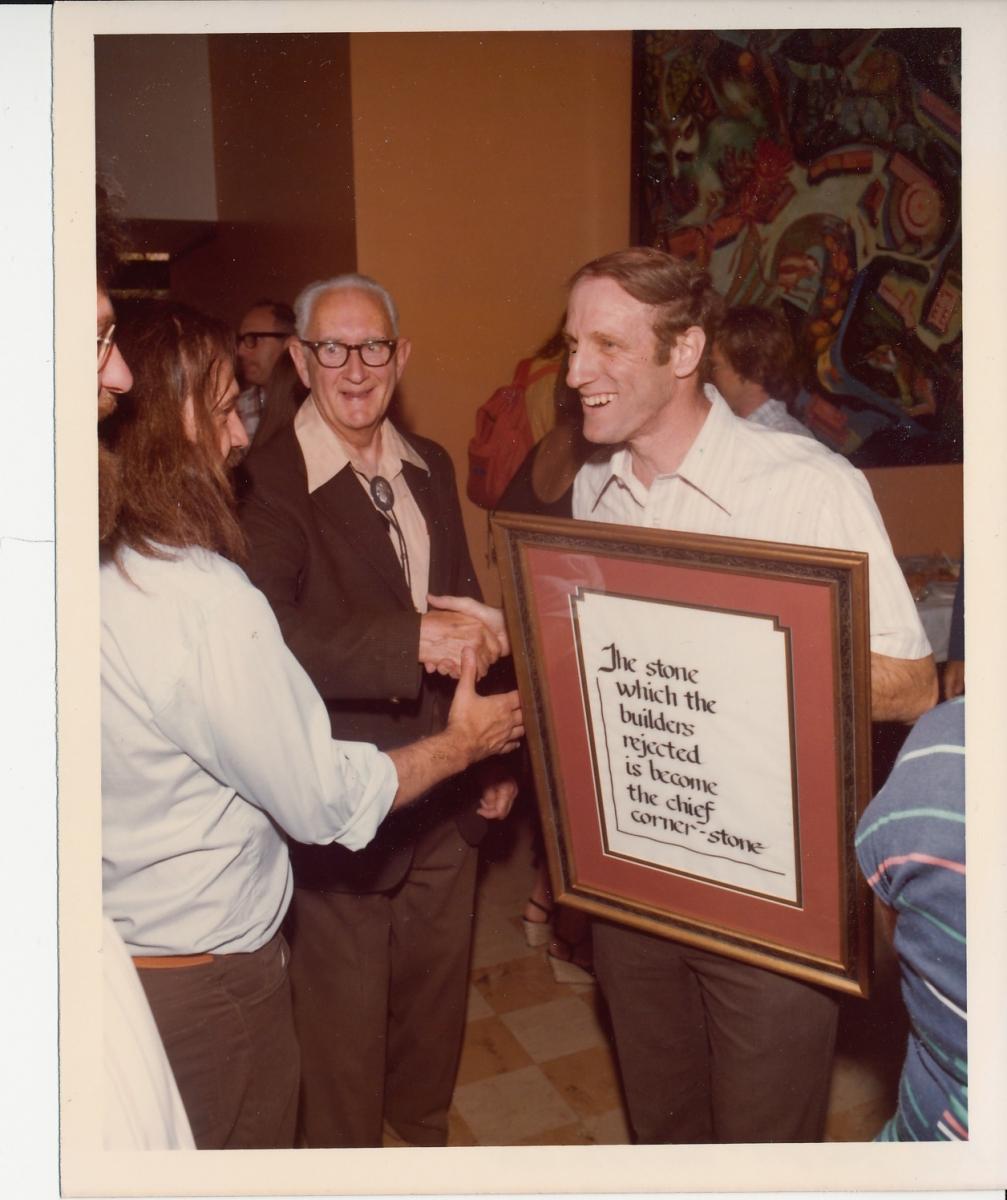 July - Budnitz farewell party
July - Budnitz farewell party
Farewell party for Budnitz. In the photo at left, Budnitz is holding a plaque, and Craig Hollowell is shaking his hand.
That year - Much of Energy and Environment moves to Building 90
The Division Office and much of the Division's staff move from the 50 complex to Building 90.
Fall - Elton Cairns is division head
Elton Cairns arrives as Energy and Environment division head following a national search.

